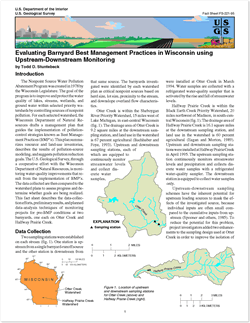Fact Sheet 221-95

IntroductionThe Nonpoint Source Water Pollution Abatement Program was created in 1978 by the Wisconsin Legislature. The goal of the program is to improve and protect the water quality of lakes, streams, wetlands, and ground water within selected priority watersheds by controlling sources of nonpoint pollution. For each selected watershed, the Wisconsin Department of Natural Resources drafts a management plan that guides the implementation of pollution-control strategies known as Best Management Practices (BMP's). This plan summarizes resource and land-use inventories, describes the results of pollution-source modeling, and suggests pollution reduction goals. The U.S. Geological Survey, through a cooperative effort with the Wisconsin Department of Natural Resources, is monitoring water-quality improvements that result from the implementation of BMP's. The data collected are then compared to the watershed plans to assess progress and determine whether goals are being realized. This fact sheet describes the data-collection efforts, preliminary results, and planned data-analysis techniques of monitoring projects for pre-BMP conditions at two barnyards, one each on Otter Creek and Halfway Prairie Creek. |
Posted November 2008 For additional information contact: Part or all of this report is presented in Portable Document Format (PDF). The latest version of Adobe Reader or similar software is required to view it. Download the latest version of Adobe Reader, free of charge. |
Stuntebeck, Todd D., 1995, Evaluating Barnyard Best Management Practices in Wisconsin using Upstream-Downstream Monitoring: U.S. Geological Survey Fact Sheet 221-95, 4 p.
Introduction
Data Collection
Results
Planned Data Analysis
Additional Images/Figures
References Cited
| AccessibilityFOIAPrivacyPolicies and Notices | |
 |
|